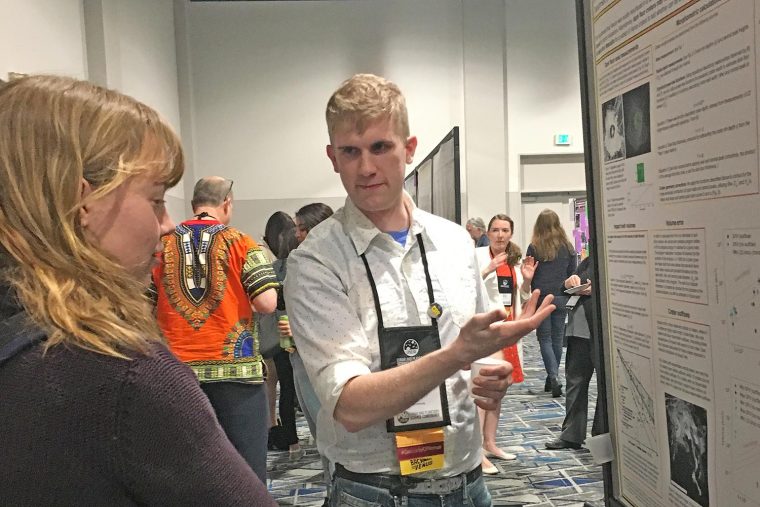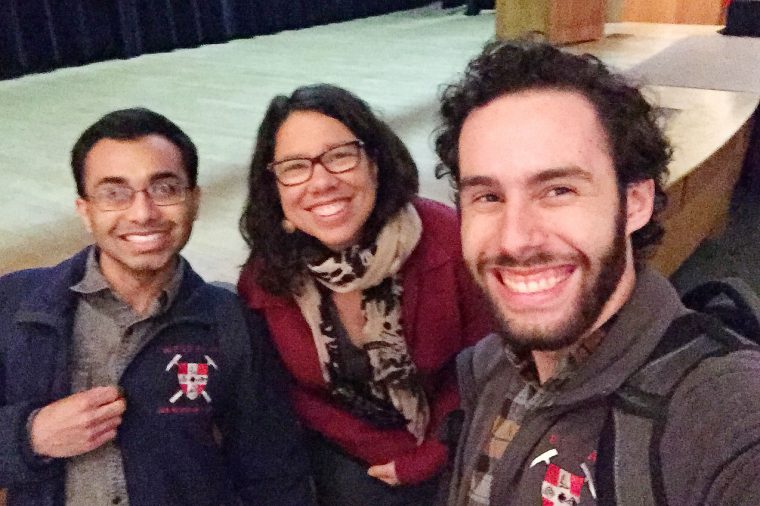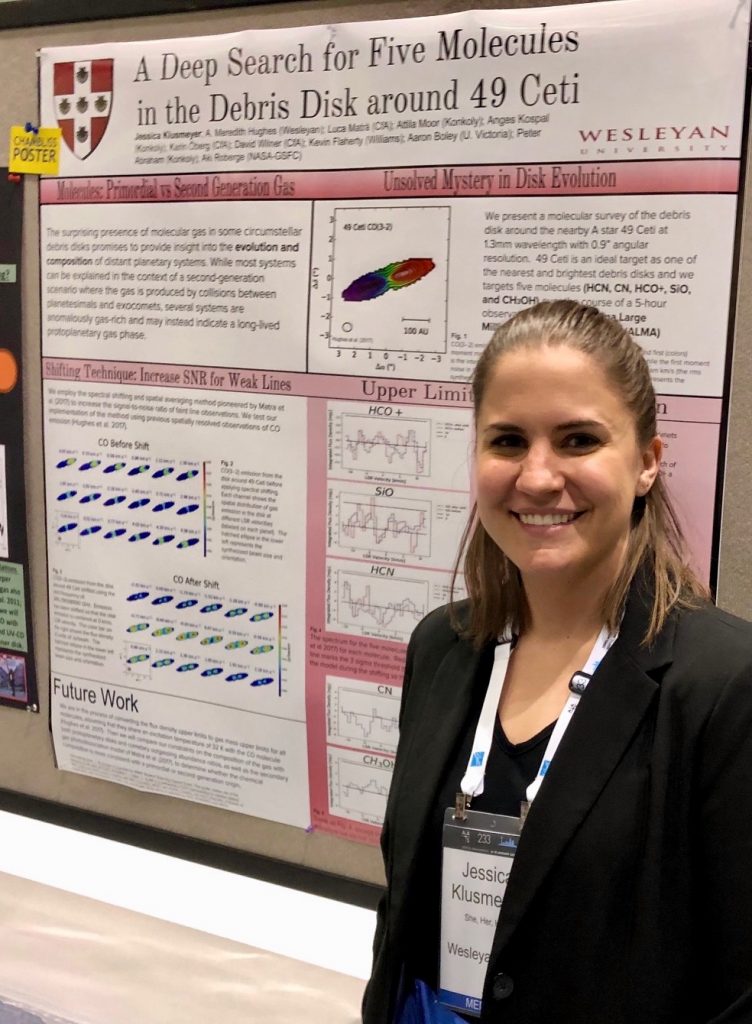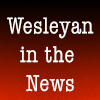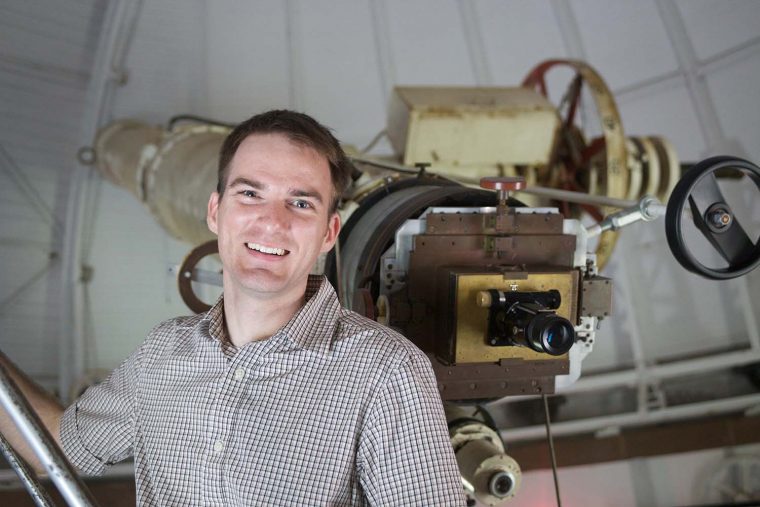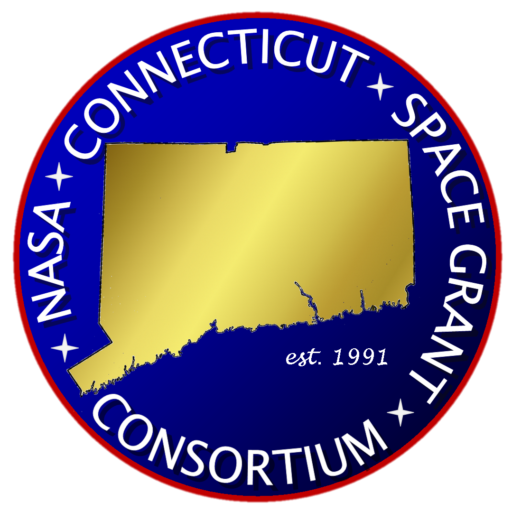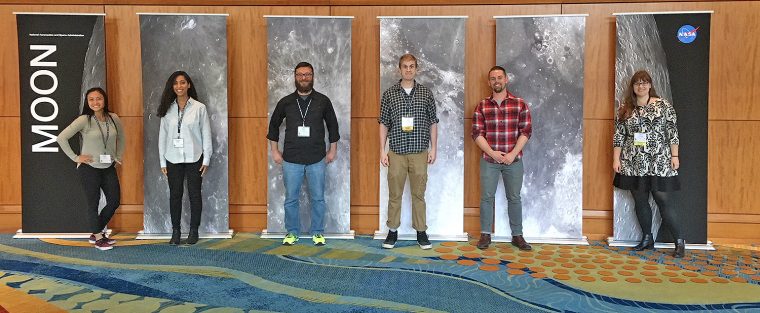A paper by John Monroe Van Vleck Professor of Astronomy William Herbst and Assistant Professor of Earth and Environmental Sciences James Greenwood will be published in the September 2019 issue of Icarus, published by Elsevier. The paper is available online. The paper, titled "Radiative Heating Model for Chondrule and Chondrite Formation," presents a new theory of how chondrules and chondrites (the most common meteorites) formed. It suggests a new approach to thinking about these rocks that populate the meteorite collections on Earth. It includes both theory and experiments (completed in Greenwood's lab in Exley Science Center). These laboratory experiments demonstrate that porphyritic olivine…
Several Wesleyan students, faculty, and alumni attended the 50th Lunar and Planetary Science Conference (LPSC) March 18-22 in The Woodlands, Texas. Members of the Wesleyan Planetary Sciences Group presented their research on a range of planetary bodies. This annual conference brings together international specialists in petrology, geochemistry, geophysics, geology, and astronomy to present the latest results of research in planetary science. Earth and environmental studies major Emmy Hughes '20 presented a poster titled “Observations of Transverse Aeolian Ridges in Digital Terrain Models" during a session on “Planetary Aeolian Processes.” Earth and environmental science graduate student Reid Perkins MA '19 presented a…
Martha "Marty" Gilmore, the George I. Seney Professor of Geology and professor of earth and environmental sciences, presented a talk at the American Museum of Natural History on Feb. 4 titled "Venus: One Fate of a Habitable Planet." Gilmore's presentation was part of the museum's Frontiers Lecture Series, which highlights the latest advances in our knowledge of the universe by presenting the work of scientists at the cutting edge of astrophysics. Gilmore, a planetary geologist, uses surface mapping and orbital spectroscopy to study Venus's terrain. During her talk, she spoke about the planet's oldest rocks and what they can tell us about the…
After a star forms, a dusty ring of space debris may begin orbiting around a star. These circumstellar disks are composed of asteroids or collision fragments, cosmic dust grains, and gasses. Astronomy graduate student Jessica Klusmeyer is interested in understanding the molecular composition of the debris disk gas. "It has important implications not only for our knowledge of debris disks but also for planet formation," she said. Klusmeyer joined more than 25 Wesleyan affiliates and shared her research during the 233rd American Astronomical Society Meeting Jan. 6-10 in Seattle, Wash. The American Astronomical Society (AAS) awarded Klusmeyer a Chambliss medal for her poster presentation…
In this recurring feature in The Wesleyan Connection, we highlight some of the latest news stories about Wesleyan and our alumni. Recent Wesleyan News 1. Los Angeles Times: "As the World Warms, Deadly and Disfiguring Tropical Diseases Are Inching Their Way Toward the U.S." In this op-ed, Professor of Biology Frederick Cohan and Isaac Klimasmith '20, both in the College of the Environment, write that infectious disease is a growing threat, resulting from climate change, that humans may find hard to ignore. Cohan is also professor, environmental studies and professor, integrative sciences. 2. Hartford Courant: "Trump's Immoral Response to Climate Report" Gary Yohe, the…
On Oct. 15, Seth Redfield, associate professor and chair of astronomy, gave a lecture at the Morrison Planetarium at the California Academy of Sciences. He was invited to speak as part of the Benjamin Dean Astronomy Lecture series. The title of his talk was, "Exploring Our Galactic Neighborhood." The talk will be posted to the Academy's iTunes University site. Redfield is also associate professor, integrative sciences, and co-coordinator, planetary science.
Like planet Earth, the geology of Venus is diverse; consisting of areas of flat plains and deformed, mountain-like terrains called tesserae. And like Earth, Mars, and the Moon, Venus is checkered with hundreds of craters. “What's odd about Venus's craters, is that craters we do see are relatively young, indicating the surface of Venus has been covered by planet-wide volcanic flows," says Martha "Marty" Gilmore, George I. Seney Professor of Geology, professor of earth and environmental sciences. “The tesserae are the only terrains older than these volcanic flows and thus our only hope at accessing rocks from the first billion…
Three undergraduates and one graduate student received NASA Connecticut Space Grant Awards from the NASA Connecticut Space Grant Consortium (CTSGC). The CTSGC is a federally mandated grant, internship, and scholarship program that aims to inspire the pursuit of careers in science, technology, engineering, and mathematics. Astronomy and math major Nicole Zalewski '20 received a $5,000 undergraduate research fellowship to pursue her study on “Measurement of the Radar Properties of the Oldest Rocks on Venus to Constrain Mineralogy." Her advisor is Martha Gilmore, the George I. Seney Professor of Geology, professor of earth and environmental sciences, co-coordinator of planetary science, and…
The Association of Universities for Research in Astronomy (AURA), which operates the Hubble Space Telescope, the James Webb Space Telescope, the U.S. National Optical Astronomy Observatory (NOAO), and other major astronomical research facilities in the United States, has elected the Keck Northeast Astronomy Consortium (KNAC)—led by Wesleyan University—as a new member. This historic development represents the first time that liberal arts institutions have been invited to join the association and serves as an important recognition of the value of such programs, not just to education, but also to frontier research in astronomy. “This is a tremendous recognition of the important…
(more…)
Faculty, graduate students, and alumni attended the 49th Lunar and Planetary Science Conference March 19–23 in The Woodlands, Texas. Three graduate students were awarded funds from the NASA Connecticut Space Grant that allowed them to travel to this meeting. Earth and environmental sciences graduate student Reid Perkins presented a research poster titled "Where Are the Missing Tessera Craters on Venus?" Perkins's advisor is Martha Gilmore, the George I. Seney Professor of Geology, professor of earth and environmental sciences. Earth and environmental sciences graduate student Melissa Luna presented a poster titled "Multivariate Spectral Analysis of CRISM Data to Characterize the Composition of Mawrth…
Connecticut Public Radio tapped Joshua Boger ’73, P’06, ’09, chair emeritus of the Wesleyan Board of Trustees, for his recollections of a historic flight he had taken back in 2007 with noted physicist Stephen Hawking, who died March 14 at the age of 76. The flight had been sponsored by Zero Gravity Corporation and provided, for those on board, eight zero-G opportunities—or "eight brief windows of weightlessness," as WNPR correspondent Patrick Skahill described them in his story, “Remembering The Flight Where Stephen Hawking Went Weightless.” Boger had written in detail about the experience of this zero-G flight with Hawking in "Weightless But Weighty" in Wesleyan magazine, 2007…


